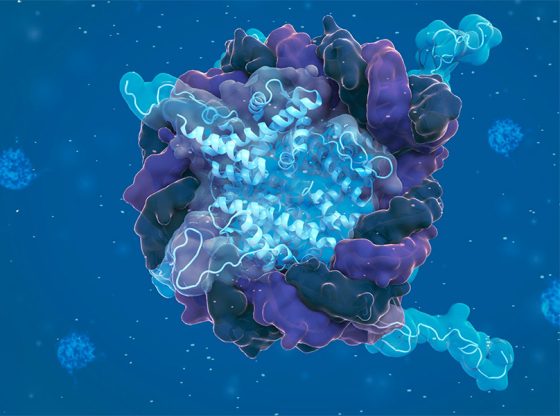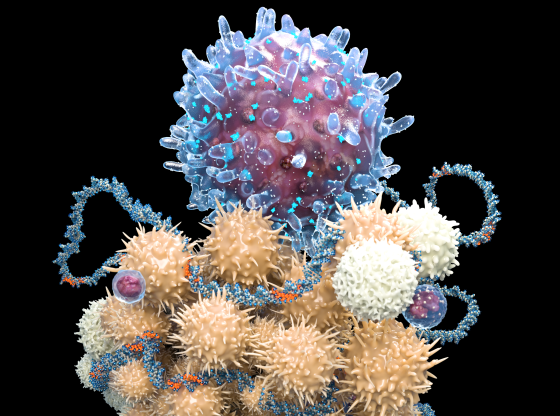by Bridget Kuehn
Uncovering how sex differences in gene expression may contribute to disease.
In many diseases or clinical traits, prevalence, severity, and other aspects differ by sex — and doctors know these differences exist, according to Barbara Stranger, PhD, an associate professor in the Department of Pharmacology. “But for the most part,” she says, “scientists haven’t known what causes them.”
Some investigators have hypothesized that hormones, the sex chromosomes themselves, differences in behavior, or environmental exposures may contribute to sex differences, explains Stranger, who is also a member of Northwestern’s Center for Genetic Medicine. Now, she and her colleagues have begun to reveal some of the underlying mechanisms.
More than 13,000 human genes are expressed at different levels in males and females, including genes important in drug metabolism, body fat, breast cancer, and birth weight, according to a study led by Stranger and involving a multi-institution team of collaborators. The study, published in Science, found that 37 percent of genes were expressed at different levels in male and female subjects across 44 different human tissues. The massive trove of information produced in this study will lay the groundwork for understanding sex-related differences in health and disease for decades to come.
CONSIDERING SEX
Stranger and an international team of colleagues analyzed the expression of more than 35,000 genes in 44 post-mortem tissues using data from 838 deceased adult donors as part of the National Institutes of Health’s (NIH) Genotype-Tissue Expression (GTEx) Project. Previous studies had analyzed sex differences in only a handful of tissues, she says, but the GTEx and NIH’s support enabled the team to develop the most comprehensive catalogue of sex-differences in gene expression to date. The scale of the study was so massive that no one laboratory could have pulled it off alone, according to Stranger, who chairs the Biological Sex working group of the GTEx Consortium. “It was a great opportunity at the right time,” she says.
The scientists found widespread but subtle sex differences in gene expression throughout the tissues, says study lead author Meritxell Oliva, a postdoctoral scholar at the University of Chicago and a visiting scholar at Northwestern. More study is needed to determine the exact origins of the differences, but according to Oliva, they may be leftovers from early development. “The overall picture is that there are lots of them, but they have very small effects,” Oliva says.
The differences were also largely specific to each tissue type, says Stranger, whose laboratory focuses on creating and applying leading-edge techniques to understand how genetic differences and genetic regulation translate into physical or physiological characteristics. “It’s not just that the sex differences are ubiquitous,” Stranger says. “It’s very controlled in each tissue type, so that makes us think that there must be a reason for that.”
Transcription factors — genes that control the expression of other genes — appear responsible for some of the differences. Others appear to be the result of genes escaping X-linked gene regulation. Stranger explains that in females, one of the two X chromosomes they receive from their parents is silenced in each cell to help balance gene expression between females and males, who receive one X and one Y chromosome. But some genes on the X chromosome escape inactivation in females. There also appears to be epigenetic differences contributing to sex-bias in gene expression.
Some of their discoveries have important implications for medicine. For example, they discovered previously unknown sex differences in genes that affect how an individual metabolizes certain medications, a finding that could have implications for the treatment of many diseases. Stranger says that, historically, many preclinical studies have included only male mice, and women have been excluded from or underrepresented in clinical studies. This limits the amount of information available about female-specific responses to drugs or dosing considerations. But by looking at sex-specific genetic regulation of gene expression, they identified 58 new sex-specific links between genes and traits, including birth weight, blood pressure, cholesterol levels, breast cancer, and body fat. Interestingly, they also discovered that 35 previously reported links between genes and traits were driven by effects in only one sex. This new knowledge was directly enabled by looking for sex differences.
“We were able to identify links with diseases and complex traits that could not have been identified without considering sex,” Oliva says. For example, they found some genes expressed more in female subjects were linked to breast cancer or autoimmune conditions like inflammatory bowel disease, which are more common among females. They also found higher expression of genes associated with baldness and body fat in male subjects.
OPENING DOORS
Although Stranger, who is a geneticist by training, has been interested in sex differences her entire career, she hasn’t always found a receptive audience with other scientists. In fact, she noted that for a variety of reasons, many scientists have viewed sex as a “nuisance variable” that has to be adjusted for.
“Until recently, the impact of sex on the genetic basis of disease has been grossly understudied,” she says.
One program that has both helped get her career off the ground and get more scientists interested in sex differences was a $100,000 grant supplement offered by the NIH’s Office on Women’s Health Research. As a junior faculty member, Stranger approached more senior colleagues working on NIH grant-funded research to apply for the supplements to examine sex differences in their studies.

“It was a great way to get my lab started,” she says. “A lot of investigators and trainees have benefited from that program, and it boosted the science of sex differences and expanded the pool of scientists working in that area.” Now, Stranger, who joined Northwestern’s faculty in September 2019, says it has been gratifying to work at an institution that supports the study of sex differences. “I feel like the type of research I do is valued here,” she says.
Stranger says she hopes the study published in Science also helps eliminate the misperception that research on sex differences is only about women’s health.
“Although women’s health has been historically understudied and needs attention, the study of sex as a biological variable can uncover discoveries valid for either sex that remain masked when males and females are studied together as a single group,” she says. “As demonstrated in this study, consideration of sex as a biological variable can generate new knowledge that could benefit anyone.”
The study has already led to a flurry of collaborations with scientists working on many diseases. For example, Stranger is collaborating with experts in drug response to understand how sex differences in gene expression may affect the way women and men respond to drugs. She is also studying differences in gene expression in tumors in males and females with different types of cancer and will compare those to the differences she and her colleagues have documented in healthy tissues.
“We are using the Science study as a reference for looking at sex differences in cancer,” she says. What they discover could lead to new approaches to personalizing care for cancer that take sex differences into account. Stranger was nominated for the 2020 Top 10 Clinical Research Achievement Award as a result of the publication.
Oliva, who is currently focusing on trait-linked epigenetic features, believes more effort should be put toward studying the role epigenetics play in sex-differences in gene expression. For example, she’d like to see research focused on exploring whether modifying epigenetic marks affects sex-differences in the expression of genes important for drug metabolism. She would also like to have her hypothesis that epigenetic differences between males and females originate in early development tested.
Applying emerging technology to future studies may also lead to new insights. For example, Oliva says she envisions applying single-cell gene transcription or epigenetic analysis in future studies to map the specific cell type origins of sex-biases in gene expression.
In the meantime, Stranger says the Science study and the techniques used in it will likely lay the groundwork for new insights in many fields.
“We can apply our approach across lots of different diseases and traits,” Stranger says. “That’s really exciting to me, because we spent so much time trying to figure out the best way or ways to do these kinds of analyses and interpret them, and now, let’s go do them.”










